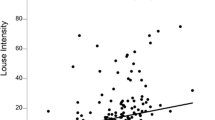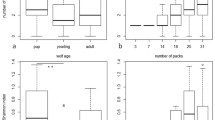Abstract
The role of parasites in influencing the trophic dynamics of hosts is becoming increasingly recognized in the ecological literature. Echinococcus granulosus is a tapeworm that relies on the predator-prey relationship between the definitive host (wolf, Canis lupus) and the intermediate host, (moose, Alces alces) to complete its life cycle. Heavy infection by E. granulosus may predispose moose to increased risk of predation by wolves. Theory predicts that parasite-induced vulnerability to predation will reduce the degree of aggregation of parasites in a host population. We tested for different levels of aggregation of E. granulosus in moose in areas of low, moderate, and high levels of wolf predation using Green’s coefficient of dispersion. Parasite aggregation was lower in an area with high predation rate, thus we hypothesize that heavy infection by E. granulosus predisposes moose to predation by wolves. This increase in predation rate due to parasite infection may influence the role of wolves in regulating moose populations. We discuss alternative explanations for the negative correlation between predation rate and parasite aggregation.

Similar content being viewed by others
References
Adjei EL, Barnes A, Lester RJG (1986) A method for estimating possible parasite-related host mortality illustrated using data from Callitetrarhynchus gracilis (Cestoda: Trypanorhyncha) in lizardfish (Saurida spp.). Parasitology 92:227–243
Anderson RM, Gordon DM (1982) Processes influencing the distribution of parasite numbers within host populations with special emphasis on parasite-induced host mortalities. Parasitology 85:373–398
Boutin S (1992) Predation and moose population dynamics: a critique. J Wildl Manage 56:116–127
Crête M, Rivest L-P, Jolicoeur H, Brassard J-M, Messier F (1986) Predicting and correcting helicopter counts of moose with observations made from fixed-wing aircraft in southern Québec. J Appl Ecol 23:751–761
Gasaway WC, Boertje RD, Grangaard DV, Kelleyhouse DG, Stephenson RO, Larsen DG (1992) The role of predation in limiting moose at low densities in Alaska and Yukon and implications for conservation. Wildl Monogr 120
Gordon DM, Rau ME (1982) Possible evidence for mortality induced by the parasite Apatemon gracilis in a population of brook sticklebacks (Culaea inconstans). Parasitology 84:41–47
Gray DR (1993) The use of muskox kill sites as temporary rendezvous sites by arctic wolves with pups in early winter. Arctic 46:324–330
Green RH (1966) Measurement of non-randomness in spatial distributions. Res Popul Ecol 8:1–7
Hadeler KP, Freedman HI (1989) Predator-prey populations with parasitic infection. J Math Biol 27:609–631
Hayes RD, Harestad AS (2000) Wolf functional response and regulation of moose in the Yukon. Can J Zool 78:60–66
Hudson PJ, Dobson AP, Newborn D (1992) Do parasites make prey vulnerable to predation? Red grouse and parasites. J Anim Ecol 61:681–692
Ihaka R, Gentleman R (1996) R: a language for data analysis and graphics. J Comput Graph Stat 5:299–314
Ives AR, Murray DL (1997) Can sublethal parasitism destabilize predator-prey population dynamics? A model of snowshoe hares, predators and parasites. J Anim Ecol 66:265–278
Janovy J Jr, Kutish GW (1998) A model of encounters between host and parasite populations. J Theor Biol 134:391–401
Joly DO, Patterson BR (2003) Use of selection indices to model the functional response of predators. Ecology 84:1635–1639
Keymer AE, Anderson RM (1979) The dynamics of infection of Trilobium confusum by Hymenolepis diminuta: the influence of infective-stage density and spatial distribution. Parasitology 79:195–207
Krebs CJ (1999) Ecological methodology, 2nd edn. Harper Collins, New York
Lafferty KD (1999) The evolution of trophic transmission. Parasitol Today 15:111–115
McNeill MA, Rau ME (1987) Echinococcus granulosus (Cestoda: Taeniidae) infections in moose (Alces alces) from southwestern Québec. J Wildl Dis 23:418–421
Mech LD (1970) The wolf: the ecology and behavior of an endangered species. Natural History Press, New York
Messier F (1985a) Social organization, spatial distribution, and population density of wolves in relation to moose density. Can J Zool 63:1068–1077
Messier F (1985b) Solitary living and extraterritorial movements of wolves in relation to social status and prey abundance. Can J Zool 63:239–245
Messier F (1994) Ungulate population models with predation: a case study with the North American moose. Ecology 75:478–488
Messier F (1996) On the functional and numerical responses of wolves to changing prey density. In: Carbyn LN, Fritts SH, Seip DR (eds) Ecology and conservation of wolves in a changing world. University of Alberta Press, Edmonton, pp 187–197
Messier F, Crête M (1985) Moose-wolf dynamics and the natural regulation of moose populations. Oecologia 65:503–312
Messier F, Joly DO (2000) Comment: the regulation of moose density by wolf predation. Can J Zool 78:506–510
Messier F, Rau ME, McNeill MA (1989) Echinococcus granulosus (Cestoda: Taeniidae) infections and moose-wolf population dynamics in southwestern Québec. Can J Zool 67:216–219
Murray DL, Cary JR, Keith LB (1997) Interactive effects of sublethal nematodes and nutritional status on snowshoe hare vulnerability to predation. J Anim Ecol 66:250–264
Myers JH (1978) Selecting a measure of dispersion. Environ Entomol 7:619–621
Pennycuick L (1971) Frequency distributions of parasites in a population of three-spined sticklebacks, Gasterosteus aculeatus L., with particular reference to the negative binomial distribution. Parasitology 63:389–406
Peterson RO (1977) Wolf ecology and prey relationships on Isle Royale. National Park Service Science Monograph no. 11, Washington, D.C.
Post E, Peterson RO, Stenseth NC, McLaren BE (1999) Ecosystem consequences of wolf behavioural response to climate. Nature 410:905–907
Rau ME, Caron FR (1979) Parasite-induced susceptibility of moose to hunting. Can J Zool 57:2466–2468
Rausch RL (1995) Life cycle patterns and geographic distribution of Echinococcus species. In: Thompson RCA , Lymbery AJ (eds) Echinococcus and hydatid disease. CAB International, Wallingford, pp 90–134
Rousset F, Thomas F, De Meeûs T, Renaud F (1996) Inference of parasite-induced host mortality from distributions of parasite loads. Ecology 77:2203–2211
Shaw DJ, Dobson AP (1995) Patterns of macroparasite abundance and aggregation in wildlife populations: a quantitative review. Parasitology 111(Suppl):S111–S133
Shaw DJ, Grenfell BT, Dobson AP (1998) Patterns of macroparasite aggregation in wildlife host populations. Parasitology 117:597–610
Siegel S, Castellan NJ (1988) Nonparametric statistics for the behavioral sciences, 2nd edn. McGraw-Hill, New York
Sokal RR, Rohlf FJ (1995) Biometry, 3rd edn. Freeman, New York
Thompson RCA (1995) Biology and systematics of Echinococcus. In: Thompson RCA , Lymbery AJ (eds) Echinococcus and hydatid disease. CAB International, Wallingford, pp 1–37
Tompkins DM, Begon M (1999) Parasites can regulate wildlife populations. Parasitol Today 15:311–313
Van Ballenberghe V, Ballard WB (1994) Limitation and regulation of moose populations: the role of predation. Can J Zool 72:2071–2077
Acknowledgements
This manuscript was improved by comments from C. Osenberg, K. Lafferty, S. Ferguson, D. Gummer, T. Armstrong and B. Patterson and an anonymous reviewer. We are grateful to A. Plante for technical support. Financial support for the original study was provided by the Canadian National Sportmen’s Shows, the Natural Sciences and Engineering Research Council of Canada (NSERC), and the Ministère du Loisir, de la Chasse et de la Pêche du Québec. Damien O. Joly was supported by the University of Saskatchewan and Natural Sciences and Engineering Research Council of Canada and subsequently the USGS-National Wildlife Health Center.
Author information
Authors and Affiliations
Corresponding author
Additional information
An erratum to this article can be found at http://dx.doi.org/10.1007/s00442-004-1802-1
Rights and permissions
About this article
Cite this article
Joly, D.O., Messier, F. The distribution of Echinococcus granulosus in moose: evidence for parasite-induced vulnerability to predation by wolves?. Oecologia 140, 586–590 (2004). https://doi.org/10.1007/s00442-004-1633-0
Received:
Accepted:
Published:
Issue Date:
DOI: https://doi.org/10.1007/s00442-004-1633-0




